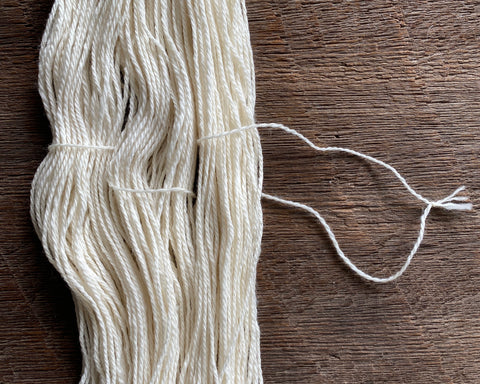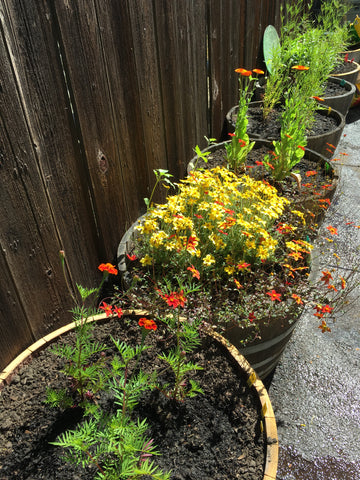News / dye-it-yourself
May - Dye-It-Yourself: Mordanting

It’s May! Some of our dye gardens are growing, others are still getting ready. Are you taking photos of your garden process? If so, we’d love to see them. You can always post them on social media, tagging @sinceresheep and using the hashtag #sinceresheepdiy, or if you’re not on social media, you can email us. We are so excited to share in your garden joy!
As we continue our year-long Dye-It-Yourself series, there might be no better topic for May than mordanting. Mordanting an important step in the natural dye process, and it’s something you can do while you wait for your garden to grow. And if you'd like to skip this step completely I have listed some mordanted Cormo yarn so you can get straight to the dyeing!
But what is mordant, and why is it important to the natural dye process? Mordant is a substance that is used to set or bind dyes to plant fibers (like cotton or linen) or protein fibers (like silk or wool) by forming a chemical bridge between the dye and the fiber. Without a mordant, natural dyes won’t stick as effectively to plant or protein fibers. Mordants are often made from minerals, although tannins can also be used in the mordanting process with cellulose. Your choice of mordant--whether it be Alum, Copper, Iron, or Tannins--will affect the ultimate color of the dye you use. For this project, we recommend using Alum (Potassium Aluminum Sulfate) as a mordant for your protein fiber yarns.
There’s no need to wait to mordant your yarn, either! Planning ahead and getting your mordanting done before you’re ready to dye can be smart. If you do this work ahead of time, you won’t be trying to fit it in when your plants are ready for harvest and dyeing.
Whenever you start the mordanting process, you probably want to start your Dyer’s Notebook. In your notebook, you can write down what yarn you are using, what mordant you’re using, and any other things you want to remember during the dyeing process.
Here’s the mordanting process we recommend for protein yarn:

- Step 1 – ‘Dye-tie’ your yarn. – Using un-dyed waste yarn, loosely tie your skein of yarn in 2 places using a figure eight. Also check to see how the ends of the skein were tied and re-tie loosely if necessary. You want to leave lots of room so the ties don’t restrict the dye.
- Step 2 – Weigh your yarn. – Before you get your yarn wet, weigh your skeins in grams. If you don’t have a scale but the yarn was labeled with a weight, use that figure. Be sure to write this number down.
- Step 3 – Scour your yarn. – Either fill your sink or your top-loading washing machine with hot water. Once you have the right amount of water, add a few drops of dish soap and submerge your yarn in the water. Leave the yarn for at least a half an hour before you either spin it out or gently squeeze it out. If there is too much residual soap in the yarn, repeat this process omitting the soap on the second round. Be gentle; you want to avoid agitating the yarn.
- Step 4 – Mordant your yarn. – Multiply the total weight of your yarn by 15% to figure out the amount of Alum you need for mordanting. Weigh or measure the amount of Alum into a measuring cup. Dissolve the Alum in boiling water. Fill your dye-dedicated stainless steel or enamel pot with enough cold water to cover your yarn and add your dissolved mordant. Place the yarn in the pot and slowly heat, bringing to right below a simmer. Ideally your yarn should be at this temperature for about an hour. Turn off the heat and let your yarn sit for a minimum of an hour, or overnight.
- Step 5 – Rinse your yarn. – Wearing gloves, remove your yarn from the mordant and gently squeeze out excess liquid. Fill up your sink or top-loading washing machine with cold water and put your mordanted yarn in for a very brief soak to rinse off any excess mordant. Spin out or gently squeeze out your yarn. Your yarn is now ready to dye!
Resources for where to buy alum:
Books and websites with info about mordanting:
- The Art & Science of Natural Dyes by Joy Boutrup & Catherine Ellis
- The Modern Natural Dyer by Kristine Vejar
- Maiwa's guide to natural dyes
Third Wave of Planting
This month is also our third and final wave of planting! If you haven’t yet planted your garden, now is the time.
January - Dye-It-Yourself: Garden Planning

Happy New Year! We are so excited about what we have planned for you in 2020 here at Sincere Sheep. In addition to all of the usual goodness, including newsletters, Made Here Club shipments, classes, and shows, this month, we’re beginning a new year-long blog series: Dye-It-Yourself.
As you might imagine, we have so much DIY fun planned! We’ll be guiding you through this dyeing journey from the very beginning. We’ll assist you in planning a dye garden, selecting the seeds to grow, growing your plants (and suggesting fun food-based natural dye and stain projects to tide you over while you wait for your plants to grow), harvesting your dyestuffs, the actual dyeing itself, and finally, seed saving. We can all share photos of our progress, process, successes, and more on Instagram with the hashtag #sinceresheepdiy
This month, we’re starting to plan our garden, and we hope you’ll join us and start planning your own. We’ll suggest ways for you to start planning, as well as helpful resources if you’re excited to start reading more about natural dyes right now.
Find Your Growing Zone
Sincere Sheep is located in beautiful Napa, California. In our area, this is the time of year that’s cooler and wetter than in the summer months. Even though we don’t get terribly severe cold winter weather, we still observe growing seasons. This is the time of year when we think about our garden for the coming year. If you’re in the Northern Hemisphere, chances are the same is true for you.

The 2012 USDA Plant Hardiness Zone Map is the standard by which gardeners and growers can determine which plants are most likely to thrive at a given location. The map is based on the average annual minimum winter temperature, divided into 10-degree F zones. You can type in your zip code to determine what zone you are in. A good place to start planning any garden is to figure out your zone and maybe even begin to familiarize yourself with what kinds of plants grow best in your area.
Determine Your Garden Space
Some people have lots of space for planting, and others have room for only a few pots on a windowsill. Take a look at the space around you. What kind of sun do certain areas get? Where would plants thrive? As a rule of thumb most dye plants need at least half the day in sun and two-thirds generally is better. Begin to think about what could work for you.
Dreams and Reality
As you start to plan your garden, by all means, dream big. Think of all the things you might want to grow, how beautiful they will look, and all the amazing things you will dye. Maybe you’ve been wanting to do a garden for years, and this is the perfect opportunity! Or maybe it’s a great reason to finally get moving on those raised beds you’ve been contemplating. Make lists if you want! Maybe even draw color-coded diagrams of your dream garden, if that helps you find a vision that you love.
But keep in mind that growing and maintaining a garden of any kind, including a dye garden, takes resources, including time and space. It doesn’t have to be an expensive project, but chances are you will have to buy some seeds and buy or borrow some gardening tools if you don’t already have them. This reality check is not intended to dampen your enthusiasm. It’s merely a suggestion that If you’re new to keeping a garden, maybe limit yourself to 2-3 types of dye plants, and see how it goes this year. You’ll be weeding, watering, and engaging in related garden care over the growing season. You don’t want to spread yourself too thin or get to July and feel totally overwhelmed by all the plant children in need of attention.
Dye Plant Options
Don’t worry too much at this point about choosing which particular dye plants you will grow. Get a sense of what’s possible for you in your space. We’ll get into seed sourcing next month, but shades of yellow are the most widely available. We’ll be talking mostly about the following six plants in the coming year:
- Dyer’s coreopsis (bronzy-yellow)
- Dyer’s chamomile (yellow)
- Marigolds (gold)
- Sulphur Cosmos (orange/yellow)
- Weld (clear yellow)
- Indigo (blue)
Working Together
I know, I know. Some of you are thinking, “How could I possibly limit myself to 2-3 types of plants? I want more colors!” If this is you, consider cooperating with other people who are also excited about this project. If you can find a partner either in your region or outside of your region, you have the opportunity to widen your options for dyestuffs. For example, maybe your time, space, and location will allow you to grow Marigolds and Dyer’s Coreopsis. But you’re so excited to try indigo, and you have this terrible sinking feeling that you’ll be missing out. One way to assuage your FOMO is to find (or make!) a friend who’ll grow plants different from yours and will trade with you after harvest time. Start asking around to see who might want to do this project with you!
Resources For Learning About Natural Dyeing
As you begin to dream about your garden, you may find yourself wondering about more of the specifics around natural dyeing. Here are some suggestions for books and online resources that we respect, find accessible to the beginning natural dyer, and will help you create more lasting natural color on fiber. Some of these books are out of print but you can still find them. Also, remember that your library is a great resource for these books.
Books
A Dyer’s Garden, by Rita Buchanan (1995)
A Weaver’s Garden, by Rita Buchanan (1987)
Harvesting Color, by Rebecca Burgess (2011)
The Modern Natural Dyer, by Kristine Vejar (2015)
The Art and Science of Natural Dyes: Principles, Experiments, and Results, by Joy Boutrup & Catherine Ellis (2019)
A Garden to Dye For, by Chris McLaughlin (2014)
10 Plants for Color by Deepa Preeti Natarajan & Helen Krayenhoff
Online
https://www.fs.fed.us/wildflowers/ethnobotany/dyes.shtml
Turkey Red Journal: https://www.turkeyredjournal.com/
Graham Keegan: http://www.grahamkeegan.com/indigo-vat-basics
Ecotone Threads / Kori Hargreaves: http://www.ecotonethreads.com/
Catherine Ellis: https://blog.ellistextiles.com/


